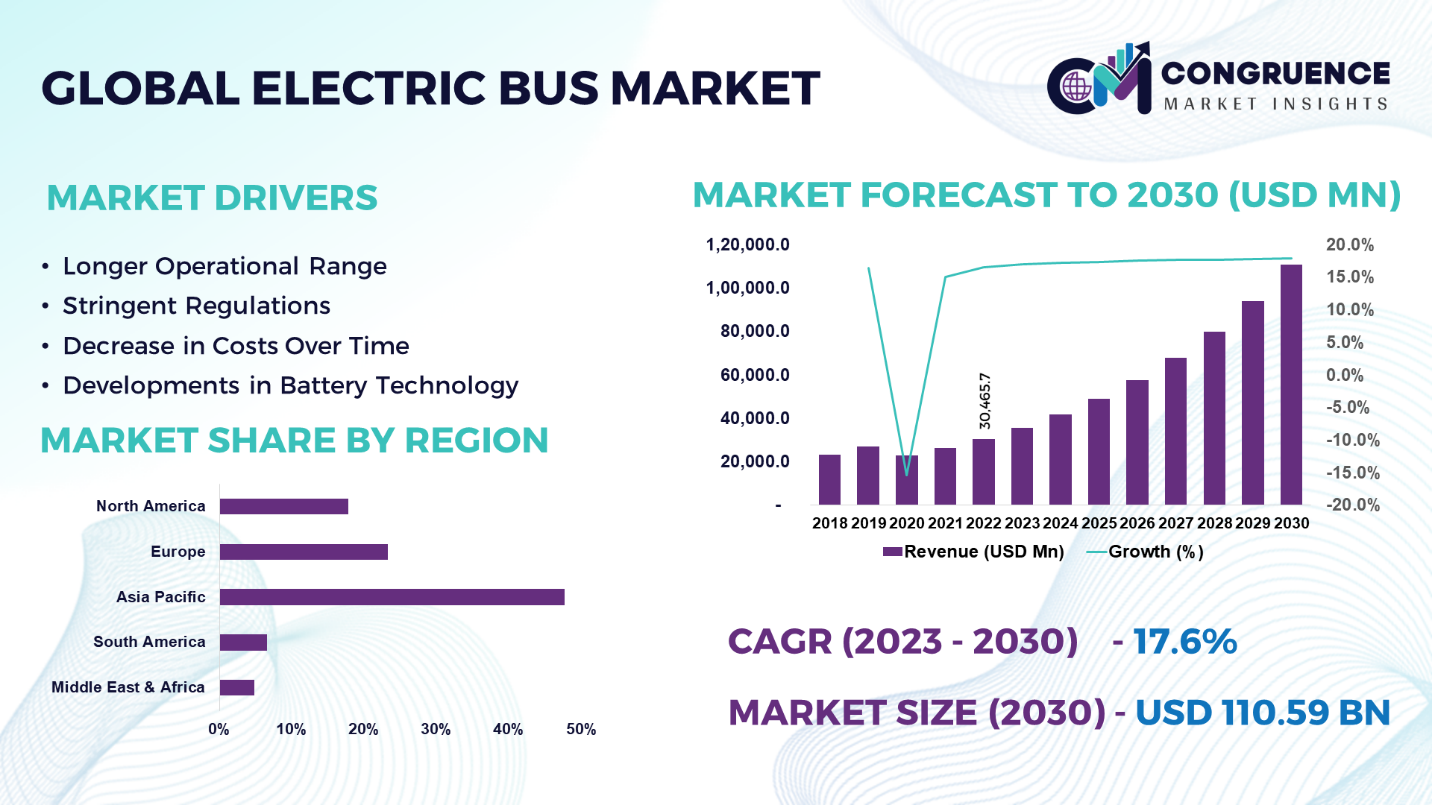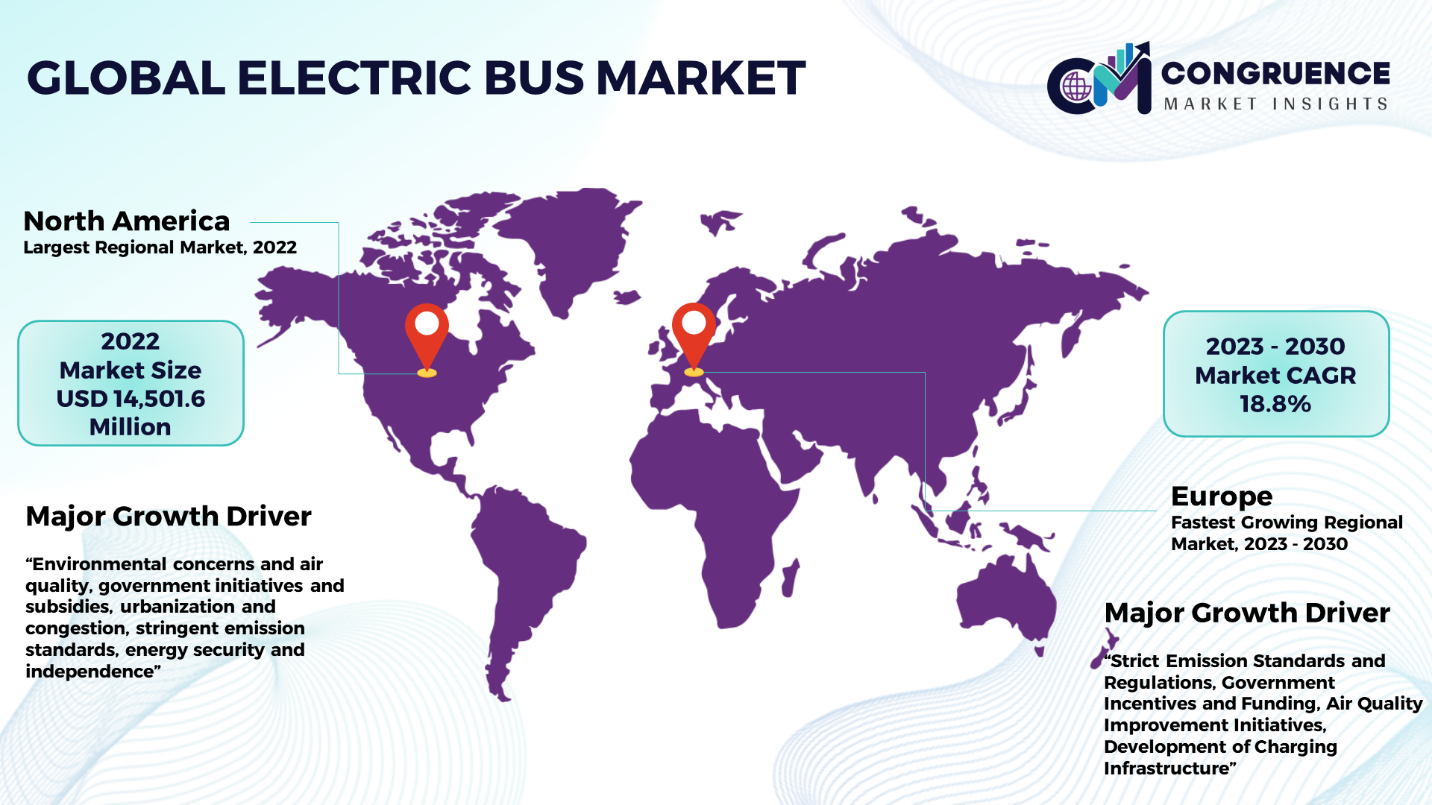Reports
The Global Electric Bus Market was valued at USD 30,465.7 Million in 2022 and is anticipated to reach a value of USD 110,588.6 Million by 2030 expanding at a CAGR of 17.6% between 2023 and 2030.
An electric bus moves forward by using electric motors rather than internal combustion engines. When it comes to power supplies, electric buses may either store the energy they need on board or get constant external power. Most buses that carry electricity are battery electric buses (the main topic of this page), in which an onboard battery pack powers the electric motor. Some storage types do exist; however, they are uncommon. One example is the flywheel energy-storing gyrobus. When not stored on board, electricity is acquired by contact with external power sources. The industry is witnessing an increase in demand for non-polluting, anti-air pollution, and fuel-efficient buses. Furthermore, government initiatives to achieve zero emissions objectives, stringent regulations, and escalating environmental concerns are driving the development of electric buses. Automakers' expenditures in developing hydrogen fuel cell-powered electric buses are another factor driving demand. The growing expenditures made by battery manufacturers in creating more reasonably priced, technologically advanced batteries is also expected to drive the e-bus business.

Electric Bus Market Major Driving Forces
Longer Operational Range: The industry is expanding due to the fact that e-buses with a range of more than 200 miles may cover a greater distance on a single charge. Longer routes are better suited for these kinds of vehicles. When compared to regular buses, this makes them more affordable, which presents an opportunity for the worldwide electric bus industry.
Stringent Regulations: The adoption of strict government rules and regulations pertaining to vehicle emissions in several countries has forced automakers to employ cutting-edge technology in order to battle excessively high levels of emissions in buses. This is anticipated to drive the growth of the global market for electric buses.
Decrease in Costs Over Time: Over time, electric buses become more economically feasible due to the falling costs of electric vehicle (EV) technology, particularly batteries. This trend incentivizes transit operators to make long-term investments in electric buses in order to reduce operational expenses.
Developments in Battery Technology: The improved energy density and longer life cycles of batteries, which are ongoing advancements in battery technology, add to the enhanced range and dependability of electric buses. Transit operators will find electric buses more feasible as batteries grow more efficient.
Electric Bus Market Key Opportunities
Eco-Friendly and Sustainable Options: The market for electric buses has an opportunity to grow and promote sustainable solutions due to the growing demand for environmentally friendly transportation. By encouraging and inspiring people to switch from conventional combustion engine automobiles to electric ones, manufacturers may profit from this trend.
Evolving Battery Technology: Battery electric vehicles are becoming increasingly popular in the electric bus industry due to its benefits, which include a shift in public opinion on the use of electric buses in both developed and developing nations. Additionally, battery electric buses require less maintenance and require less sophisticated technology than other traditional buses, which is anticipated to accelerate the global electric bus market's growth.
Emergence of Plug-in Hybrid Electric Vehicles: Plug-in hybrid electric vehicles reduce CO2 emissions and the burning of diesel fuel by up to 75%, which stimulates market expansion. Furthermore, the ability of PHEV batteries to be charged by an internal combustion engine (ICE), via a wall outlet or charging station, or by regenerative braking is anticipated to fuel the expansion of the worldwide electric bus industry.
Electric Bus Market Key Trends
· Due to cost reductions and developments in battery technology, battery electric buses (BEBs) dominated the electric bus industry.
· Key developments in battery technology include ongoing advancements in energy density, quicker charging times, and extended life cycles.
· Integrating infrastructure for quick charging emerged as a popular idea.
· Multi-modal transportation hubs gained popularity by integrating electric buses with other environmentally friendly transit options like trains and bicycles.
· When assessing electric buses, transit authorities and operators are increasingly taking the whole cost of ownership into account.
· Energy management systems and smart charging options for electric bus fleets became popular.
· Growing interest in electric buses as a way to lessen local pollution was prompted by growing worries about the quality of the air in metropolitan areas.
Region-wise Market Insights
North America accounted for the largest market share at 47.6% in 2022 whereas, Europe is expected to register the fastest growth, expanding at a CAGR of 18.8% between 2023 and 2030.

During the projected time, Asia Pacific is anticipated to be the largest market for electric buses with the market share of 47.6%, accounting USD 14,501.7 Million. The primary cause of this is the region's rising desire to lessen its reliance on fossil fuels and urban pollution, as well as the expanding government efforts aimed at promoting clean public transit. In the electric bus market, this area is home to some of the top players, such as BYD (China), Yutong (China), King Long (China), Zhongtong (China), Tata Motors (India), Ashok Leyland (India), and JBM Auto Limited (India). The development of infrastructure for charging, as well as the decrease in the cost of batteries and EVS, present a significant possibility for market expansion. Presently holding a 23.3% market share, Europe is anticipated to exhibit robust development with the fastest CAGR of 18.8% over the projected period, positioning it as the second largest market. The primary driver of this region's market expansion is the government's strict regulations on vehicle emissions. Numerous governments in this region have begun to use clean and green transportation technology in an effort to make city public transit sustainable. This area is seeing an increase in demand for fuel cell buses as well. It is also expected that North America would exhibit distinct expansion in the worldwide market. It is anticipated that the United States would expand steadily in this area. In the upcoming years, the market is probably going to grow because of this country's strict emission regulations.
Market Competition Landscape
One of the main characteristics of the global electric bus market is the intense rivalry among several producers. Important participants in the electric bus industry employ tactics meant to provide them a competitive advantage. In order to adapt to changing customer tastes, these methods include product innovation, design distinction, and the use of eco-friendly and sustainable materials. Established companies rely on their quality and dependability reputation to hold onto market share, while more recent competitors concentrate on disruptive technologies and USPs. Key players in the global electric bus market implement various organic and inorganic strategies to strengthen and improve their market positioning. Prominent players in the market include:
· BYD Company Limited
· Proterra Inc.
· Daimler AG (Mercedes-Benz)
· VDL Groep
· Tata Motors
· Yutong Group
· Nova Bus (Volvo Group)
· ABB Group
· Ebusco
· New Flyer Industries (NFI Group)
· Zhengzhou Yutong Bus Co., Ltd.
· Siemens Mobility
· NFI Industries
· Solaris Bus & Coach
· Blue Bird Corporation
· E.V. Group (EVOBUS)
|
Report Attribute/Metric |
Details |
|
Market Revenue in 2022 |
USD 30,465.7 Million |
|
Market Revenue in 2030 |
USD 110,588.6 Million |
|
CAGR (2023 – 2030) |
17.6% |
|
Base Year |
2022 |
|
Forecast Period |
2023 – 2030 |
|
Historical Data |
2018 to 2022 |
|
Forecast Unit |
Value (US$ Mn) |
|
Key Report Deliverable |
Revenue Forecast, Growth Trends, Market Dynamics, Segmental Overview, Regional and Country-wise Analysis, Competition Landscape |
|
Segments Covered |
· By Propulsion Type (Battery Electric Vehicle, Fuel Cell Electric Vehicle, Plug-In Hybrid Electric Vehicle) · By Length (Less Than 9 Meters, 9-14 Meters, Above 14 Meters) · By Range (Less Than 150 Miles, 150 To 300 Miles, Above 300 Miles) · By Battery Capacity (Less Than 50 Kwh, 50-250 Kwh, Above 250 Kwh) · By Power Output (Up To 250 Kw, Above 250 Kw) |
|
Geographies Covered |
North America: U.S., Canada and Mexico Europe: Germany, France, U.K., Italy, Spain, and Rest of Europe Asia Pacific: China, India, Japan, South Korea, Southeast Asia, and Rest of Asia Pacific South America: Brazil, Argentina, and Rest of Latin America Middle East & Africa: GCC Countries, South Africa, and Rest of Middle East & Africa |
|
Key Players Analyzed |
BYD Company Limited, Proterra Inc., Daimler AG (Mercedes-Benz), VDL Groep, Tata Motors, Yutong Group, Nova Bus (Volvo Group), ABB Group, Ebusco, New Flyer Industries (NFI Group), Zhengzhou Yutong Bus Co., Ltd., Siemens Mobility, NFI Industries, Solaris Bus & Coach, Blue Bird Corporation, E.V. Group (EVOBUS) |
|
Customization & Pricing |
Available on Request (10% Customization is Free) |
